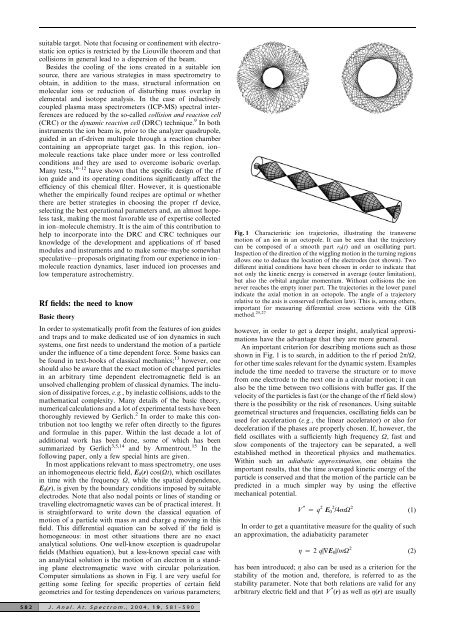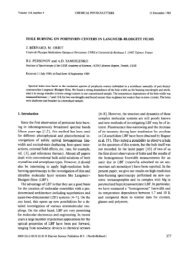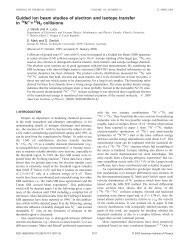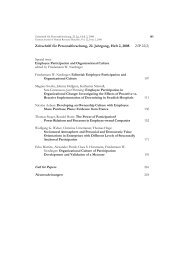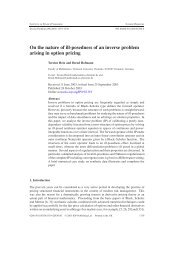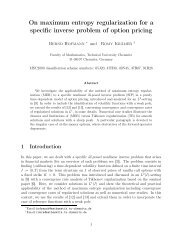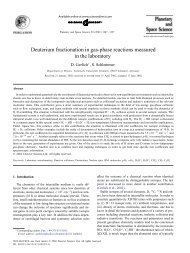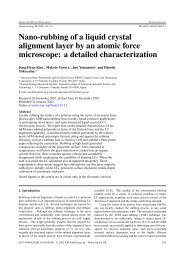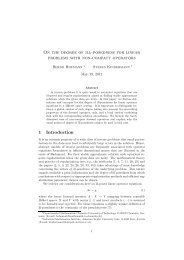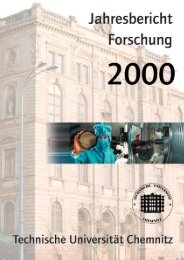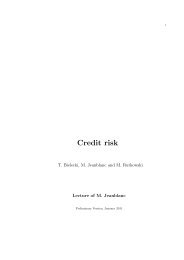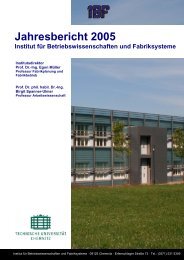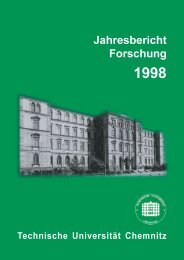Applications of rf fields and collision dynamics in atomic mass ...
Applications of rf fields and collision dynamics in atomic mass ...
Applications of rf fields and collision dynamics in atomic mass ...
Create successful ePaper yourself
Turn your PDF publications into a flip-book with our unique Google optimized e-Paper software.
suitable target. Note that focus<strong>in</strong>g or conf<strong>in</strong>ement with electrostatic<br />
ion optics is restricted by the Liouville theorem <strong>and</strong> that<br />
<strong>collision</strong>s <strong>in</strong> general lead to a dispersion <strong>of</strong> the beam.<br />
Besides the cool<strong>in</strong>g <strong>of</strong> the ions created <strong>in</strong> a suitable ion<br />
source, there are various strategies <strong>in</strong> <strong>mass</strong> spectrometry to<br />
obta<strong>in</strong>, <strong>in</strong> addition to the <strong>mass</strong>, structural <strong>in</strong>formation on<br />
molecular ions or reduction <strong>of</strong> disturb<strong>in</strong>g <strong>mass</strong> overlap <strong>in</strong><br />
elemental <strong>and</strong> isotope analysis. In the case <strong>of</strong> <strong>in</strong>ductively<br />
coupled plasma <strong>mass</strong> spectrometers (ICP-MS) spectral <strong>in</strong>te<strong>rf</strong>erences<br />
are reduced by the so-called <strong>collision</strong> <strong>and</strong> reaction cell<br />
(CRC) or the dynamic reaction cell (DRC) technique. 9 In both<br />
<strong>in</strong>struments the ion beam is, prior to the analyzer quadrupole,<br />
guided <strong>in</strong> an <strong>rf</strong>-driven multipole through a reaction chamber<br />
conta<strong>in</strong><strong>in</strong>g an appropriate target gas. In this region, ion–<br />
molecule reactions take place under more or less controlled<br />
conditions <strong>and</strong> they are used to overcome isobaric overlap.<br />
Many tests, 10–12 have shown that the specific design <strong>of</strong> the <strong>rf</strong><br />
ion guide <strong>and</strong> its operat<strong>in</strong>g conditions significantly affect the<br />
efficiency <strong>of</strong> this chemical filter. However, it is questionable<br />
whether the empirically found recipes are optimal or whether<br />
there are better strategies <strong>in</strong> choos<strong>in</strong>g the proper <strong>rf</strong> device,<br />
select<strong>in</strong>g the best operational parameters <strong>and</strong>, an almost hopeless<br />
task, mak<strong>in</strong>g the most favorable use <strong>of</strong> expertise collected<br />
<strong>in</strong> ion–molecule chemistry. It is the aim <strong>of</strong> this contribution to<br />
help to <strong>in</strong>corporate <strong>in</strong>to the DRC <strong>and</strong> CRC techniques our<br />
knowledge <strong>of</strong> the development <strong>and</strong> applications <strong>of</strong> <strong>rf</strong> based<br />
modules <strong>and</strong> <strong>in</strong>struments <strong>and</strong> to make some–maybe somewhat<br />
speculative—proposals orig<strong>in</strong>at<strong>in</strong>g from our experience <strong>in</strong> ion–<br />
molecule reaction <strong>dynamics</strong>, laser <strong>in</strong>duced ion processes <strong>and</strong><br />
low temperature astrochemistry.<br />
Rf <strong>fields</strong>: the need to know<br />
Basic theory<br />
In order to systematically pr<strong>of</strong>it from the features <strong>of</strong> ion guides<br />
<strong>and</strong> traps <strong>and</strong> to make dedicated use <strong>of</strong> ion <strong>dynamics</strong> <strong>in</strong> such<br />
systems, one first needs to underst<strong>and</strong> the motion <strong>of</strong> a particle<br />
under the <strong>in</strong>fluence <strong>of</strong> a time dependent force. Some basics can<br />
be found <strong>in</strong> text-books <strong>of</strong> classical mechanics; 13 however, one<br />
should also be aware that the exact motion <strong>of</strong> charged particles<br />
<strong>in</strong> an arbitrary time dependent electromagnetic field is an<br />
unsolved challeng<strong>in</strong>g problem <strong>of</strong> classical <strong>dynamics</strong>. The <strong>in</strong>clusion<br />
<strong>of</strong> dissipative forces, e.g., by <strong>in</strong>elastic <strong>collision</strong>s, adds to the<br />
mathematical complexity. Many details <strong>of</strong> the basic theory,<br />
numerical calculations <strong>and</strong> a lot <strong>of</strong> experimental tests have been<br />
thoroughly reviewed by Gerlich. 2 In order to make this contribution<br />
not too lengthy we refer <strong>of</strong>ten directly to the figures<br />
<strong>and</strong> formulae <strong>in</strong> this paper. With<strong>in</strong> the last decade a lot <strong>of</strong><br />
additional work has been done, some <strong>of</strong> which has been<br />
summarized by Gerlich 3,5,14 <strong>and</strong> by Armentrout. 15 In the<br />
follow<strong>in</strong>g paper, only a few special h<strong>in</strong>ts are given.<br />
In most applications relevant to <strong>mass</strong> spectrometry, one uses<br />
an <strong>in</strong>homogeneous electric field, E0(r) cos(Vt), which oscillates<br />
<strong>in</strong> time with the frequency V, while the spatial dependence,<br />
E0(r), is given by the boundary conditions imposed by suitable<br />
electrodes. Note that also nodal po<strong>in</strong>ts or l<strong>in</strong>es <strong>of</strong> st<strong>and</strong><strong>in</strong>g or<br />
travell<strong>in</strong>g electromagnetic waves can be <strong>of</strong> practical <strong>in</strong>terest. It<br />
is straightforward to write down the classical equation <strong>of</strong><br />
motion <strong>of</strong> a particle with <strong>mass</strong> m <strong>and</strong> charge q mov<strong>in</strong>g <strong>in</strong> this<br />
field. This differential equation can be solved if the field is<br />
homogeneous: <strong>in</strong> most other situations there are no exact<br />
analytical solutions. One well-know exception is quadrupolar<br />
<strong>fields</strong> (Mathieu equation), but a less-known special case with<br />
an analytical solution is the motion <strong>of</strong> an electron <strong>in</strong> a st<strong>and</strong><strong>in</strong>g<br />
plane electromagnetic wave with circular polarization.<br />
Computer simulations as shown <strong>in</strong> Fig. 1 are very useful for<br />
gett<strong>in</strong>g some feel<strong>in</strong>g for specific properties <strong>of</strong> certa<strong>in</strong> field<br />
geometries <strong>and</strong> for test<strong>in</strong>g dependences on various parameters;<br />
582 J. Anal. At. Spectrom., 2004, 19, 581–590<br />
Fig. 1 Characteristic ion trajectories, illustrat<strong>in</strong>g the transverse<br />
motion <strong>of</strong> an ion <strong>in</strong> an octopole. It can be seen that the trajectory<br />
can be composed <strong>of</strong> a smooth part r0(t) <strong>and</strong> an oscillat<strong>in</strong>g part.<br />
Inspection <strong>of</strong> the direction <strong>of</strong> the wiggl<strong>in</strong>g motion <strong>in</strong> the turn<strong>in</strong>g regions<br />
allows one to deduce the location <strong>of</strong> the electrodes (not shown). Two<br />
different <strong>in</strong>itial conditions have been chosen <strong>in</strong> order to <strong>in</strong>dicate that<br />
not only the k<strong>in</strong>etic energy is conserved <strong>in</strong> average (outer limitation),<br />
but also the orbital angular momentum. Without <strong>collision</strong>s the ion<br />
never reaches the empty <strong>in</strong>ner part. The trajectories <strong>in</strong> the lower panel<br />
<strong>in</strong>dicate the axial motion <strong>in</strong> an octopole. The angle <strong>of</strong> a trajectory<br />
relative to the axis is conserved (reflection law). This is, among others,<br />
important for measur<strong>in</strong>g differential cross sections with the GIB<br />
method. 25,27<br />
however, <strong>in</strong> order to get a deeper <strong>in</strong>sight, analytical approximations<br />
have the advantage that they are more general.<br />
An important criterion for describ<strong>in</strong>g motions such as those<br />
shown <strong>in</strong> Fig. 1 is to search, <strong>in</strong> addition to the <strong>rf</strong> period 2p/V,<br />
for other time scales relevant for the dynamic system. Examples<br />
<strong>in</strong>clude the time needed to traverse the structure or to move<br />
from one electrode to the next one <strong>in</strong> a circular motion; it can<br />
also be the time between two <strong>collision</strong>s with buffer gas. If the<br />
velocity <strong>of</strong> the particles is fast (or the change <strong>of</strong> the <strong>rf</strong> field slow)<br />
there is the possibility or the risk <strong>of</strong> resonances. Us<strong>in</strong>g suitable<br />
geometrical structures <strong>and</strong> frequencies, oscillat<strong>in</strong>g <strong>fields</strong> can be<br />
used for acceleration (e.g., the l<strong>in</strong>ear accelerator) or also for<br />
deceleration if the phases are properly chosen. If, however, the<br />
field oscillates with a sufficiently high frequency V, fast <strong>and</strong><br />
slow components <strong>of</strong> the trajectory can be separated, a well<br />
established method <strong>in</strong> theoretical physics <strong>and</strong> mathematics.<br />
With<strong>in</strong> such an adiabatic approximation, one obta<strong>in</strong>s the<br />
important results, that the time averaged k<strong>in</strong>etic energy <strong>of</strong> the<br />
particle is conserved <strong>and</strong> that the motion <strong>of</strong> the particle can be<br />
predicted <strong>in</strong> a much simpler way by us<strong>in</strong>g the effective<br />
mechanical potential.<br />
V * ~ q 2 E0 2 /4mV 2<br />
In order to get a quantitative measure for the quality <strong>of</strong> such<br />
an approximation, the adiabaticity parameter<br />
g ~ 2 q|+E0|/mV 2<br />
has been <strong>in</strong>troduced; g also can be used as a criterion for the<br />
stability <strong>of</strong> the motion <strong>and</strong>, therefore, is referred to as the<br />
stability parameter. Note that both relations are valid for any<br />
arbitrary electric field <strong>and</strong> that V * (r) as well as g(r) are usually<br />
(1)<br />
(2)


